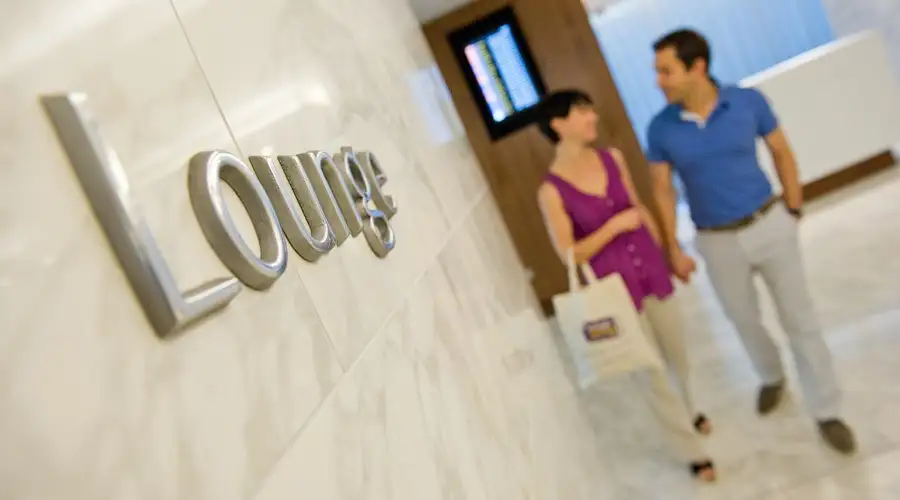
My recent trip to the Mosel Valley started out with a (delayed) flight on United from my home airport, Medford, Oregon, to San Francisco, followed by a long layover at San Francisco. Although I had a coupon for a visit to a United Club, I decided to try out the new American Express Centurion Lounge, also located in United’s post-security area. And it’s a real winner: Facilities include a shower suite and a computer bar, along with the expected array of hot and cold eats, no-charge beverages, and Wi-Fi. The more I travel, the more I find that airport lounge access is one of the most valuable features of a premium credit card—and sometimes a reasonable option even when you have to pay up to $50 for one-time non-member entry.
Big airlines have operated their own lounge networks since American opened the first Admirals Club in 1939, but independent lounges are a relatively new development here in the United States.
Related: 9 Things You Should Never Buy at the Airport
—AmEx has full Centurion Lounges in Dallas-Ft. Worth, Las Vegas, Miami, New York/LaGuardia and San Francisco, along with a smaller “Studio” in Seattle-Tacoma. Presumably, more are in the works. Access is no-charge for travelers who hold AmEx platinum cards, along with one or two guests; holders of other AmEx cards can get in, along with children under 18, for a $50 fee. Locations other than LaGuardia are airside.
—Priority Pass operates more than 700 lounges around the world, some independent, some operated by airlines. Coverage is stronger outside North America than here. The program includes airside locations of Alaska Airlines Boardroom lounges at Anchorage, Los Angeles, Portland and Seattle; seven The Club locations, and other airline or independent lounges at Baltimore, Boston, Chicago/O’Hare, Colorado Springs, Honolulu, Houston, Los Angeles, Miami, Newark, New York/JFK, Orlando and Washington/Dulles. Price options are $99 a year plus $27 per visit, $299 per year, including 10 visits, or$399 per year for unlimited visits. AmEx Platinum and Diners Club cards include Priority Pass membership, but Diners is not currently open for new members in the U.S. or Canada.
—The Club operates lounges airside at Atlanta, Cincinnati, Dallas-Ft. Worth, Las Vegas, Phoenix, San Jose and Seattle-Tacoma airports. One-day passes cost $35.
Related: 10 Free Things You Can Get at Airports
—Plaza Premium operates lounges airside at Edmonton (USAdeparture area), Toronto, and Vancouver, with Winnipeg in the works, along with 29 other locations around the world, mainly in Asia. Fees vary. About 50 Plaza Premium lounges are available to holders of some AmEx cards.
—Executive Lounges operates facilities airside at Calgary and Montreal; one-day passes start at $35.
—Airspace Lounges operates facilities airside at Baltimore, Cleveland, JFK Terminal 5 (JetBlue), and San Diego, with one-day fees starting at $25.
Airline-run lounge systems include Air Canada’s Maple Leaf, Alaska’s Boardroom, American’s Admirals Club, Delta’s Sky Club, Hawaiian’s Premier Club, United’s United Club, and Virgin America’s Loft and Clubhouse, with locations at their major service points. The big foreign-based lines operate similar lounge networks. WestJet offers reduced-price admission at Plaza Premium and a few other lounges. Typically, membership costs $300 to $500 per year, plus extra-fee spouse cards, with reduced rates for elite frequent flyers. Day passes cost $35 to $50 per person.
Related: 7 Shameless Ways to Make a Flight Comfortable
Top-level credit cards co-branded by American, Delta and United include lounge membership at annual fees that are less than regular membership fees; United’s Mileage Plus Club Card, $450 annual fee, is the most generous of the airline cards. But choice of lounge program and credit card should obviously be governed primarily by which airline you fly the most. After all, a United card doesn’t make much sense if United doesn’t fly to your home city.
Yes, $50 a pop or up to $500 a year are stiff prices. But you can offset the prices by what you might otherwise spend for food and beverages. All in all, I’m glad I have access, and once in a while, you might just agree.
You Might Also Like:
- 10 Ways to Speed Through Airport Security
- 10 Surprisingly Free Airline Perks
- 8 Cheap Ways to Enjoy a Layover
Ed Perkins on Travel is copyright (c) 2015 Tribune Media Services, Inc.
We hand-pick everything we recommend and select items through testing and reviews. Some products are sent to us free of charge with no incentive to offer a favorable review. We offer our unbiased opinions and do not accept compensation to review products. All items are in stock and prices are accurate at the time of publication. If you buy something through our links, we may earn a commission.
Top Fares From Columbus, OH
Today's Top Travel Deals
Brought to you by ShermansTravel
Shop and Save with Country Inns...
Patricia Magaña
 Hotel & Lodging Deals
Hotel & Lodging Deals
$229 -- Chicago: Discounted Rates and...
Francesca Miele
 Hotel & Lodging Deals
$229+
Hotel & Lodging Deals
$229+
$188 -- Honolulu: Save on Oceanview...
Abigail Lamay
 Hotel & Lodging Deals
$188+
Hotel & Lodging Deals
$188+



